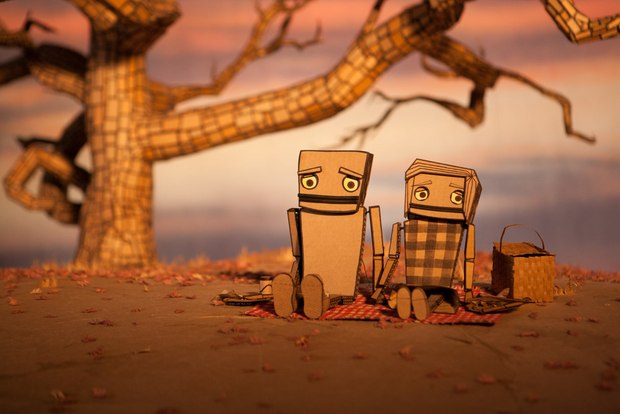Shot with Blackmagic Cinema and Pocket Cinema cameras, live action short Me + Her is readied for Sundance using Blackmagic DaVinci Resolve.
Fremont, CA -- Blackmagic Design announced that Me+Her, a live action short film by Island Creek Pictures premiering at the Sundance Film Festival, was shot on the Blackmagic Cinema Camera (MFT). The Blackmagic Pocket Cinema Camera was also used for a number of specific shots requiring a smaller camera form factor.
Me+Her is set in a fantasy world in the city of Cardboard where the main character, Jack Cardboard, goes on a journey to mend a broken heart. Director Joseph Oxford and cinematographer Bradley Stonesifer created an amazing world where all of the main characters and sets were built out of standard cardboard boxes on a one-fifth scale. In order to help bring the cardboard to life, the team needed their cameras to provide high quality images.
“The bar for shooting miniatures has been set very high with movies such as Coraline and ParaNorman. There is already a visual understanding and expectation of top quality by the audience,” Bradley said. “We tested a number of cameras, but the form factor, color space, latitude, image quality and flexibility for color correction with RAW really sold us on the Blackmagic Cinema Cameras.”
The 12-minute short film took 18 days to shoot and was shot in RAW using 10 terabytes of footage in all. Once initial shooting was completed, footage was transcoded to ProRes Lite for editing and then back to RAW files for color correction using DaVinci Resolve.
“I'm a very detail oriented person and I took extra care to put as much of that into these characters and sets as I could. Literally no detail was too small whether it be the hood ornaments on the trucks or the treads of the shoes. Shooting RAW with the Blackmagic Cinema Cameras allowed us to properly capture all of those details and get the most out of our images in color timing,” said Joseph.
“When shooting, we were in super tight, super confined spaces, and we really put the cameras through their paces. Especially with puppets, you have to think differently. We had to shoot 10 inches off the ground instead of six feet, like with a human actor. Lighting and camera angles for a film where everything is one fifth scale were unusual to say the least. And we had to think of depth of field every time we picked up the cameras. All in an attempt to empower the puppets and make them feel more like people,” Bradley said.
“The Blackmagic Cinema Camera gave us an incredibly clean and smooth image that had a huge amount of information in it. With that information, our colorist, Aaron Peak from Hollywood DI, could do a lot, which was necessary to really help bring the characters and sets to life. And the cameras and footage easily worked with our entire post production workflow, which let us be very efficient,” continued Bradley.
Throughout the production, the Blackmagic Cinema Camera was the A camera, with the Pocket Cinema Camera being used when only its small form factor could get the shot.
“It's safe to say that this film would have been exponentially more difficult to make with a larger camera. It was very important to me to minimize the limits equipment would put on us so I could operate more from a creative mindset rather than a logistical one,” said Joseph. “In the film, we had a scene where the set was 12' tall, 4' wide, and 4' deep and we had our hero traversing from the top to the bottom on a spiral chute. The walls of the set were lined with staircases and practical lighting. No standard sized camera was going to fit in that set. But luckily for us the Pocket Cinema Camera had shipped just prior to our days on that set. Its size and weight allowed us to get right in on the action of the fast paced, erratic scene.”
“At the end of everything, the Blackmagic cameras allowed a bunch of independent filmmakers to work with a ‘DIY’ attitude, proving that with a vision and hard work you can still have a high quality film, regardless of the materials being used. There is nothing stopping your creativity, and these cameras helped to make it possible,” concluded Bradley.
Source: Blackmagic Design











